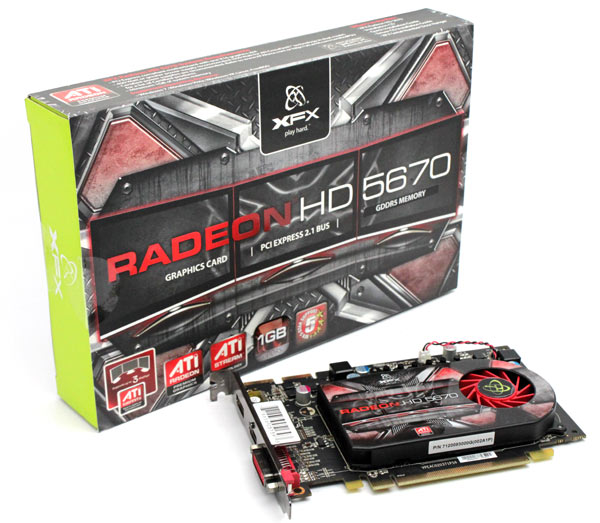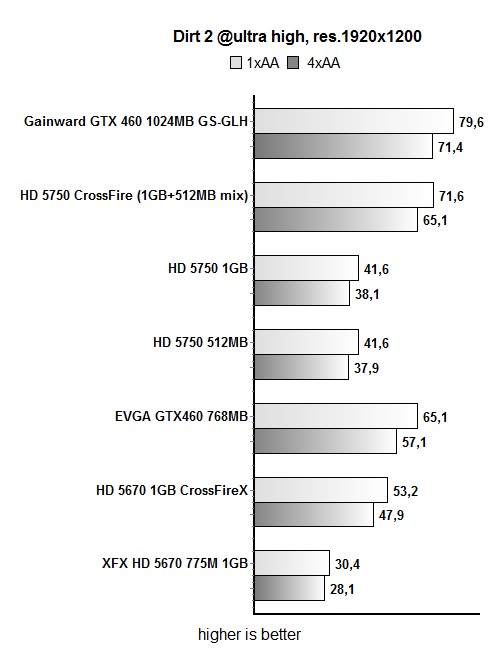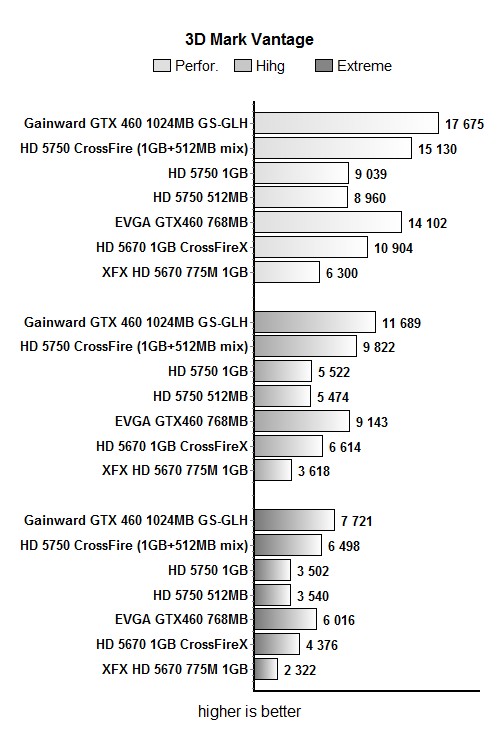Index

Review: Good bundle at a discount
Back when ATI had a nicely filled out DirectX 11 offer, Nvidia was struggling to announce its Fermi GF100 based high end GTX 480 and GTX 470 cards. It turned out thatGF100, which was announced on 26th of March, was indeed powerful but it was also large, hot and expensive to make, so Nvidia had to get down to business once again and launch the GF104.
Nvidia launched Geforce GTX 460 on 12th of July and we’re talking about a card based on GF104, which is much smaller and rakes in more profit than the GF100, but Nvidia still has no answer for the budget market. As you could’ve guessed already, our today’s card belongs in the budget market segment, whereas Nvidia’s more affordable Geforce DX11 cards won’t be ready before the end of august or back-to-school period.
Radeon HD 5670 is based on the RV830 40nm chip codenamed Redwood and it belongs to Evergreen family of DirectX 11 cards. Redwood, just like all the ATI chips so far, has been announced in two flavors; Redwood XT is used on Radeon HD 5670 whereas the slower Redwood LE ended up on Radeon HD 5570 and HD 5550 cards. The slowest ATI DirectX11 card uses Cedar chip and it’s called Radeon HD 5450.
HD 5670 is the fastest PCI-E powered Evergreen card, making this an interesting choice for HTPC owners – the card doesn’t consume much but it packs enough punch for multimedia and occasional gaming at lower detail settings. All the power is fed via the PCI-E slot, which means the card won’t consume more than 75W. AMD says the card’s maximum TDP is at 65W, whereas in idle mode it consumes only 15W.
Redwood XT chip comes with 400 stream processors, which is one quarter of what ATI’s fastest Evergreen cards have (1600). Let us refresh your memory – above Redwood you’ll find Juniper GPUs (HD 5770), which pack 800 stream processors and 128-bit memory interface. The fastest chip in the Evergreen family is known as Cypress and it comes with 1600 stream processors. Cypress-based cards (HD 5870/HD 5850) come with 256-bit memory interface and use GDDR5.
Radeon HD 5670 comes with 8 raster operation units (ROPs), 20 texture mapping units and with GDDR5 memory combined with 128-bit memory interface. Specs say that the HD 5670 isn’t your go-to card when it comes to gaming, but it does come with UVD 2.2 and will be great for multimedia.
Our XFX HD 5670 card comes with 1GB of memory, but you should know that the same card is available with 512MB of GDDR5 memory as well. XFX didn’t change GPU clocks so we’re still talking about reference clocks – 775MHz GPU and 1000MHz (4000MHz effectively) for the GDDR5 memory.
XFX HD 5670 comes in a small and appealing box. Within the box you’ll find the graphics card wrapped in plastic, driver CD, installation manual and the “Don’t bother me, I’m Gaming” door-sign. On the back of the box we learned that XFX offers its 5-Star support for the HD 5760, but in order to do that you’ll have to register on XFX’s website.

XFX HD 5670 is a small graphics card; it’s only 16.8cm long and one slot wide, making it a perfect candidate for barebone and small HTPC cases. Height-wise, this is a standard sized card so you might want to check for compatibility with smaller cases.

The cooler is miniature, with a 13-fin fan (about 5cm in diameter). There was no need for a larger cooler since the small Redwood chip (40nm, 627 million transistors, 104mm2) doesn’t get hot much.

XFX made sure that the card comes with CrossFire connectors, which aren’t there on the reference version. If you’re planning on adding another HD 5670, you can do so, but note that the second card needs a CrossFire connector as well. Of course, we decided to test the card in CrossFire mode as well and you’ll find the results on the following pages.

Apart from cooling the GPU, the cooler touches four memory modules. XFX HD 5670 1GB comes with 512MB of memory on each side of the GPU. The memory modules on the back aren’t cooled.

XFX opted on Samsung K4G10325FE-HC05 memory. The memory is rated at 1000MHz (4000MHz effectively), which combined with 128-bit memory interface allows for 64 GB/s bandwidth.
XFX HD 5670 1GB is ATI Eyefinity ready, meaning that the I/O panel comes with a DisplayPort out. There are also dual-link DVI and HDMI outs.

Testbed:
Gainward GTX 460 Golden Sample Goes Like Hell 1GB
HD 5750 512MB
HD 5750 1GB
EVGA GTX 460 768MB (675MHz/3600)
XFX HD 5670 775M 1GB
Sapphire HD 5670 1GB
Motherboard: EVGA 4xSLI
CPU: Core i7 965 XE (Intel EIST and Vdrop enabled)
Memory: 6GB Corsair Dominator 12800 7-7-7-24
Harddisk: OCZ Vertex 2 100 GB
Power Supply: CoolerMaster Silent Pro Gold 800W
Case: CoolerMaster HAF X
Fan Controler: Kaze Master Pro 5.25"
Operating System: Win7 64-bit
258.80_desktop_win7_winvista_64bit_english
10.6 CCC
Unlike reference cards, XFX’s HD 5670 1GB comes with CrossFire connectors. This means that you can boost your graphics performance by adding another card. However, the HD 5670 isn’t quite aimed at gamers so we’re not sure that many users will opt on CrossFire, but the mere fact that it is possible with XFX D 5670 1GB is pretty neat.
Two Redwood chips can score a nice frame-rate for gaming at 1680x1050.
Using two HD 5670 cards without the CrossFire bridge will result in the following message:

If the setup is done right than you will be advised to enable CrossFire for enhanced performance.


Some partners, such as Axle3D, sell the HD 5670 with one CrossFire connector and that will be enough for turning on CrossFire in ATI Catalyst.

Radeon HD 5670 is not a graphics card that will score an excellent frame rate at 1680x1050, let alone 1920x1200. Still, if you pair two of these cards, you’ll be set for some nice gaming. 30fps at 1920x1200 and no AA is pretty nice; even more so, it’s comparable to what the GTX 460 768MB scored. Users with one HD 5670 will have to settle for 1280x1024 or 1680x1050 with lower graphics settings.

XFX HD 5670 1GB scores a playable framerate in Dirt 2, even at 1920x1200.

Metro 2033 is not the game that will cut slack – not even a €200 card manages to score a playable frame-rate at 1920x1200.

The following results show that XFX HD 5670 does pretty well compared to similarly-priced cards.


XFX HD 5670 1GB is a DirectX 11 card and tessellation plays an important role. Unigine Heaven test is directly concerned with this exact feature.



All Evergreen cards come with UVD 2.2 video processor, and the HD 5670 is no exception so you can use it to decode HD video in hardware. DXVA or Direct X Video Acceleration will attempt to to accelerate content via the GPU wherever possible, taking some load off of the CPU. Using mpc-homecinema.1862 we played James Bond Quantum of Solace 1080p trailer.

The cooler is miniature and takes up only one slot. Single slot cooler is good for saving space, but a 13-fin fan with only 5cm in diameter can’t be expected to be inaudible. During FurMark, temperatures didn’t exceed 64°C, but you’ll definitely hear the fan. However, sound levels emitted by some more powerful cards in 3D mode make XFX HD 5670 1GB’s cooler one of the more silent ones. The only problem with our today’s card is that you’ll hear it when the card is in idle mode, so we guess that HTPC users won’t like it if their HTPC is in the living room.

Fan speed in auto mode climbs up to 88% RPM, whereas idle operation sees it duck to still high 50% RPM (temperatures in idle are at 37°C).
We decided to make the fan quieter so we set the RPM to 39%, which resulted in FurMark testing temperatures rising from 64°C to 70°C. Idle temperatures were at 38°C.

Radeon HD 5670 was announced on 14th of January and was at the time the most affordable DirectX 11-supporting graphics card. If you’re looking for an affordable DirectX 11 graphics card, know that the situation hasn’t changed much as Nvidia’s sub-€150 DirectX 11 offer is nowhere to be seen. AMD made sure that its offer is nicely filled out and is now reaping the rewards, as the aforementioned price segment packs a really nice offer. XFX sent us its HD 5670 1GB card, which comes based on reference design and runs at reference clocks, but comes priced at €98.
The HD 5670 offer is pretty rich with nonreference models, which almost all run on reference clocks – just like our XFX HD-567X-ZNF3 model. XFX HD 5670 comes with 1GB of GDDR5 memory and features dual-link DVI, HDMI and DisplayPort outs, which will come in handy in those three-display configurations. Apart from ATI Eyefinity support, HTPC users will really like the UVD 2.2 and integrated audio device with HDMI 1.3a support, which includes Dolby True HD and DTS Master Audio for up to 7.1 channel configurations.
Talking about gaming, you should know that the HD 5670 will allow for pleasant gaming at resolution 1280x1024. XFX HD 5670 1GB card is one of the few HD 5670 that comes with CrossFire connectors and you can use it to boost your gaming performance. As you could’ve seen for yourself in our tests, HD 5670 1GB CrossFire is capable of playable frame-rates at 1920x1200.
XFX HD 5670 1GB comes with single-slot cooling which, unlike dual-slot HD 5670, makes it a great candidate for HTPC cases. Unfortunately, the fan didn’t quite meet our requirements in idle mode. It’s far from being loud but HTPC users who keep their PC in the living room find the slightest noise pretty annoying. Good thing about it though is that you can use ATI Catalyst driver to make it completely silent.
We must say that XFX really seems to really know how to treat its customers as the company offers Aliens vs. Predator with every purchased cards, and to top it off – certain e-tailers add Dirt 2 in for a good measure. This means that you get two excellent treats which will make sure you go for instant, out-of-the-box gaming. We found the first AvP + Dirt2 bunle, and all that at about €98. If you’re looking for a single-slot HTPC card or simply an affordable multimedia DirectX 11 card, then XFX HD 5670 1GB is one choice you have to consider.



